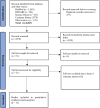Predictors of anemia among HIV-infected children in Ethiopia: systematic review and meta-analysis
- PMID: 39966543
- PMCID: PMC11836374
- DOI: 10.1038/s41598-025-85285-8
Predictors of anemia among HIV-infected children in Ethiopia: systematic review and meta-analysis
Abstract
Anemia continues to be one of the common complications among HIV-infected children. In Ethiopia, though there is a systematic review and meta-analysis study on anemia among HIV-infected children, it only disclosed the effect Highly Active Antiretroviral Treatment on HIV/AIDS-anemia comorbidity, and yet, the meta effect of other potential factors such as type of ART, presence of opportunistic infection, advanced stage of HIV/AIDS, and cotrimoxazole therapy on HIV/AIDS-anemia comorbidity have not been explored in the previous review. Therefore, this systematic review and meta-analysis aimed to identify the factors associated with anemia among HIV-infected children. Moreover, this study provides an up-to-date pooled estimate of anemia among HIV-infected children in Ethiopia. We systematically searched PubMed, HINARI, Science Direct, Cochrane Library, Google Scholar, and African Journals Online on February 3, 2024, to identify relevant primary research articles. The Briggs Institute (JBI) Checklist was used to check the quality of the original studies. Meta package for proportions (Metapro) was used to estimate the pooled prevalence of anemia among HIV-infected children using the random-effects model. Heterogeneity across studies was checked using the I-square test. Funnel plots visual inspection and Egger's tests were done to detect publication bias. The pooled prevalence of anemia among HIV-infected children in Ethiopia was 23.79% (95% CI 17.28, 31.81). Age < 7 years (OR 3.71, 95% CI 2.58; 5.33), advanced HIV disease (OR 2.78, 95% CI 2.00; 3.87), intestinal parasitic infection (OR 2.28, 95% CI 1.02; 5.09), poor ART treatment adherence (OR 1.96, 95% CI 1.23; 3.10), opportunistic infection (OR 2.81, 95% CI 1.59; 4.95), viral load > 1000 copies/ml (OR 4.29, 95% CI 2.28; 8.09), and zidovudine containing regimen (OR 5.07, 95% CI 2.41; 10.64) were identified as factors associated with a higher risk of anemia. Whereas, cotrimoxazole prophylaxis therapy (OR 0.49, 95% CI 0.35; 0.72) reduces the risk of anemia among HIV-infected children. In Ethiopia, anemia remains a public health concern among children living with HIV. Therefore, regular screening and management of anemia are important for HIV-infected children, particularly for those with advanced HIV disease, opportunistic infection, high viral load, and who are taking zidovudine-containing regimens for better clinical outcomes. Moreover, preventive chemotherapy (deworming) and counseling on infection prevention should be provided for children living with HIV to prevent parasitic infection.
Keywords: Anemia; Children; Ethiopia; HIV; Meta-analysis; Systematic review.
© 2025. The Author(s).
Conflict of interest statement
Declarations. Competing interests: The authors declare no competing interests.
Figures




References
-
- World Health Organization. Haemoglobin Concentrations for the Diagnosis of Anaemia and Assessment of Severity (World Health Organization, 2011).
-
- World Health Organization. Anaemia: What does this indicator tell us? (2008). https://www.who.int/data/nutrition/nlis/info/anaemia [cited 2024 May 12].
-
- Grantham-McGregor, S. & Ani, C. A review of studies on the effect of iron deficiency on cognitive development in children. J. Nutr.131(2), 649S–668S (2001). - PubMed
-
- Madanijah, S. et al. Assessment of anemia status on physical development skills of children under two years old in Aceh, Indonesia. J. Nutr. Sci. Vitaminol. 66(Suppl), S463–S467 (2020). - PubMed
-
- Santos, J. N. et al. Consequences of anemia on language development of children from a public day care center. Revista Paulista De Pediatria. 27, 67–73 (2009).
Publication types
MeSH terms
LinkOut - more resources
Full Text Sources
Medical

